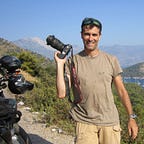Beyond Gezi: remembering Ankara’s silent protests in photos
The surprise political tremors that pervaded newsrooms across the world when spontaneous protests erupted all over Turkey on May 31st, 2013, can only be explained if the media were not paying attention to events in the Turkish capital — quite likely given that Ankara is so often overshadowed by its more beautiful sister, Istanbul
Yet for those who were watching, the previous year had seen an alarming escalation of protests and signs of growing animosity towards the government, led by then Prime Minister Recep Tayyip Erdoğan.
On October 7 a large protest of the Alevi associations filled the central Sıhhiye Square, to protest against religious discrimination.
In the next leg of the race to Gezi, Ankara’s governor controversially banned the October 29, Republic Day’s celebrations, ostensibly for ‘security reasons’, causing a small Kemalist association to mobilize. The demonstration quickly snowballed into a mammoth protest with clouds of tear gas unfolding across the city. Revealing of both increased polarization and police violence, children hanging Turkish flags were seen beaten by policemen and a dangerous standoff reached the news when opposition leader Kemal Kılıçdaroğlu’s bodyguards had to protect him from riot police.
Eventually the police let the crowd march to Ankara’s symbolic Atatürk Mausoleum. It was later revealed that this unrepeated show of mercy was at the behest of then president, Abdullah Gül. The revelation of latent presidential power triggered another prophetic crisis when Erdoğan slammed the President and the separation of powers, scolding the police for allowing people to march: “It must not happen again,” he said. And it didn’t.
On December 17 the prime minister visited the elite Middle East Technical University, known for its leftist political activism. His 105 cars, 20 armoured vehicles, 1 riot control vehicle and 2,500 policeman-strong escort clashed predictably, and with signature brutality, with students, sending one into a coma with a tear gas canister, setting the campus forest on fire and tear gassing classes, including a kindergarten.
Almost a month after the renewed repression of the May Day celebrations, which assumed new (although very quickly, normal) dimensions in Istanbul, a warning against couples kissing in public appeared in a subway station of the Capital, triggering a kissing protest — a protest that would encapsulate the Gezi spirit: good and bad. The protest was soon attacked by a mob, led by an AKP youth leader: a violent taste of things to come.
Finally, the police tried to brutally evict a few occupiers of Gezi Park. And although it was this last straw that really broke the camel’s back, Turkey’s troubles had long been brewing. Importantly, Ankara — neglected before Gezi, neglected after — would see the heightened continuation of all these processes: police brutality, religious discrimination, environmental destruction, a forgotten city whilst all eyes were on Istanbul.
But some were watching… Here is Ankara’s Gezi moment.
A man wrapped in the Turkish flag chants slogans in the “no man’s land” between protesters’ barricades and riot police protecting a government ministry in Kizilay square on June 1, a day after Ankara’s Gezi began.
A protester holding a bottle of anti-acid solution runs to catch a tear gas canister shot at the crowd.
Protesters in Kuğulu Park, Ankara, occupied in solidarity with Gezi Park on June 1.
A girl graffiti’s an anarchist slogan while people march towards the central Kizilay square, where the main demonstration is being attacked by the police.
Protesters cheer behind barricades after having repelled a charge of riot police.
A girl wearing a surgical mask as improvised protection against tear gas retreats from Kizilay square. June 2 was remembered as “Kara Pazar,” the “Black Sunday” for the police brutality and the number of people injured by tear gas canisters shot at their faces.
A line of riot police block access to Kizilay Square. Many policemen have the identification number on their helmets removed or covered with water bottle labels, a precaution that was soon abandoned.
A volunteer sprays anti-acid solution into the eyes of a protester affected by tear gas. Although this volunteers work was initially tolerated by the police, and they also helped many injured policemen, they were later prosecuted for their activities.
Riot police run towards a side street where a protest is taking place alongside rush hour traffic in Kizilay Square.
A child tries on a Guy Fawkes mask sold by a street vendor who quickly converted his merchandise to the request of the protest moment.
A water cannon attacks a demonstration in Kizilay Square over the rush hour traffic. It is marked ‘Erzurum’, one of the cities in Eastern Turkey where demonstration did not take place, allowing police to move vehicles to the capital and Istanbul.
A riot policeman shoot a tear gas canister from an armored vehicle while another shoots plastic bullets at protesters.
A protester hands out a card reading “NO VIOLENCE –there’s a festival in Kuğulu Park.”
Protesters occupying Kuğulu Park on June 15 play volleyball. One of their tents is hanging from a tree, in order to prevent accusations of illegally occupying public ground.
A protester waves a Turkish flag on a barricade on June 16.
A vigil takes place for Ethem Sarısülük, a protester shot in the head by a riot policeman. Ethem died after 13 days in a coma. The vigil took place in Güvenpark in the spot where he was hit.
A girl dances during a “forum”, a spontaneous assembly in Kuğulu Park to discuss the aftermath of the protests and the current political situation.
Students of the Fine Art Faculty of Ankara University perform the “Duran Adam”, the “Standing Man” protest in Kizilay, June 22, following harsh police crackdowns and the temporary end of mass demonstrations.
Originally published at independentturkey.org on May 31, 2016.
